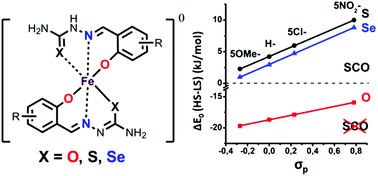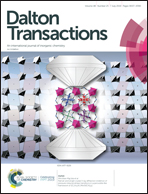Spin-crossover behavior of neutral iron(iii) complexes with salicylaldehyde thio-, seleno- and semicarbazone ligands: experiment and theoretical analysis†
Abstract
The iron(III) complex [Fe(Hsemsal)(semsal)]·3H2O (1) (H2semsal – salicylaldehyde semicarbazone) has been synthesized and characterized by powder and single crystal X-ray diffraction, and magnetic susceptibility measurements. Crystal structure analysis showed that the complex forms neat stacks stabilized by hydrogen-bonding through water molecules and π–π interactions between phenolate rings of ligands. The complex does not exhibit spin-crossover phenomena and remains in the high-spin state down to 2 K. DFT calculations were performed for a series of neutral Fe(III) complexes, and the influence of the N2S2O2, N2Se2O2 and N2O4 coordination environment on the spin transition in these complexes was traced. The effect of substituents in the benzene ring of salicylaldehyde on the stabilization of the HS or LS states in complexes of this type was analyzed.



 Please wait while we load your content...
Please wait while we load your content...